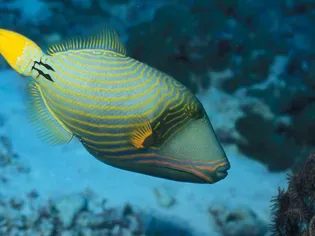Triggerfish Family Balistidae Profile
Updated on 04/26/24

Unveiling the Intriguing World of Triggerfish: A Comprehensive Profile of the Balistidae Family
Introduction
Prepare to dive into the captivating world of the triggerfish family, Balistidae, a diverse group of marine fish renowned for their vibrant colors, distinctive anatomy, and fascinating behaviors. This comprehensive blog post will provide an in-depth profile of this unique family, exploring their biology, ecology, and the remarkable adaptations that have made them a captivating subject of study and admiration for marine enthusiasts and scientists alike.
Anatomical Distinctiveness
Triggerfish possess a distinctive body plan that sets them apart from other fish species. Their bodies are laterally compressed, with a deep and short profile. This hydrodynamic shape allows them to maneuver swiftly through the water column, making them formidable predators.
Their most prominent feature is the presence of a dorsal fin spine, which is composed of three parts. The first two spines are small and can be locked into place by the third spine, which acts as a trigger. When threatened, triggerfish erect this dorsal fin spine, locking it into place and creating a formidable defensive mechanism. This unique adaptation has given the family its common name.
Captivating Coloration
Triggerfish exhibit a wide array of vibrant and intricate color patterns, making them visually stunning inhabitants of coral reefs. Their scales often display bold and contrasting hues, with intricate patterns and markings. Some species, such as the clown triggerfish (Balistoides conspicillum), feature a striking black and white striped pattern, while others, like the Picasso triggerfish (Rhinecanthus aculeatus), showcase a mesmerizing abstract pattern that resembles a painting.
Exceptional Dentition
Triggerfish possess a powerful beak-like mouth equipped with strong teeth, which they use to crush the shells of their prey, including crustaceans, mollusks, and even sea urchins. Their teeth are continuously growing and are constantly being replaced, ensuring a sharp and efficient bite throughout their lifetime.
Habitat and Distribution
Triggerfish are predominantly found in tropical and subtropical waters around the world, with the greatest diversity occurring in the Indo-Pacific region. They inhabit a wide range of habitats, including coral reefs, seagrass beds, and rocky shores. Some species, such as the black triggerfish (Melichthys niger), are pelagic and can be found in open water.
Feeding Ecology
Triggerfish are carnivorous predators that primarily feed on invertebrates. Their powerful jaws and specialized dentition allow them to crush the hard exoskeletons of their prey. They exhibit a variety of feeding behaviors, including ambush predation, where they lie in wait for unsuspecting prey, and aggressive hunting, where they actively pursue their targets. Some triggerfish species, such as the titan triggerfish (Balistoides viridescens), are known to form feeding aggregations, where large groups of individuals cooperate to capture and consume prey.
Symbiotic Relationships
Triggerfish have evolved fascinating symbiotic relationships with other marine organisms. The most well-known example is the cleaning symbiosis between triggerfish and cleaner wrasses (Labroides spp.). Triggerfish visit cleaning stations, where cleaner wrasses remove parasites and dead tissue from their bodies. This symbiotic relationship provides mutual benefits, as the triggerfish receive essential cleaning services, while the cleaner wrasses obtain a reliable source of food.
Reproductive Strategies
Triggerfish exhibit a variety of reproductive strategies. Some species, such as the ornate triggerfish (Balistes vetula), are territorial and form monogamous pairs during the breeding season. Others, like the yellowmargin triggerfish (Pseudobalistes flavimarginatus), are harem-forming, where a single male mates with multiple females. The males of harem-forming species often establish and defend territories that contain multiple nesting sites.
Conservation Status
Triggerfish populations are facing increasing threats due to overfishing and habitat destruction. Overfishing for human consumption and the aquarium trade has significantly reduced the abundance of triggerfish in many areas. Habitat destruction, including coral reef degradation and coastal development, further exacerbates these threats. Some triggerfish species are considered vulnerable or endangered, highlighting the need for conservation efforts to protect these fascinating and important marine animals.
Conclusion
The triggerfish family, Balistidae, is a fascinating and diverse group of marine fish that captivates with their vibrant colors, unique anatomy, and remarkable adaptations. Their ability to crush hard-shelled prey, engage in symbiotic relationships, and exhibit complex reproductive strategies makes them a captivating subject of study for scientists and marine enthusiasts alike. As we continue to explore the depths of the ocean, the triggerfish family will undoubtedly provide us with countless more insights into the intricate wonders of marine life. By understanding and appreciating their biology and ecology, we can contribute to the conservation and preservation of these extraordinary creatures, ensuring their presence in our oceans for generations to come.
Explore More Pets

Freshwater Aquarium Filters
How to Deal With Cloudy Aquarium Water

Saltwater Aquarium Filters
How Do You Remove Chloramines From Tap Water?

Freshwater Aquariums & Habitat
Can I Keep My Koi Fish Inside?

Saltwater Aquariums & Habitat
14 Best Floating Plants for Your Aquarium

Freshwater Fish Health
How to Treat Ich on Freshwater Fish

Saltwater Fish Health
Fin Rot in Aquarium Fish

Freshwater Aquarium Filters
How to Do Aquarium Water Changes

Saltwater Fish Health
How Do Fish Get Parasites?